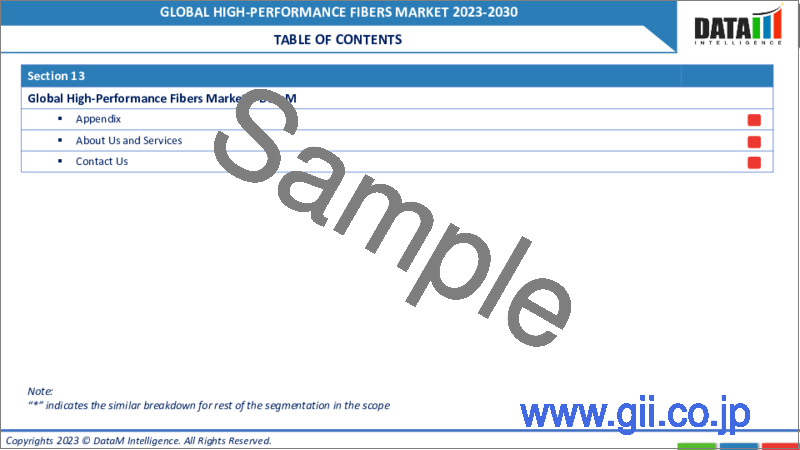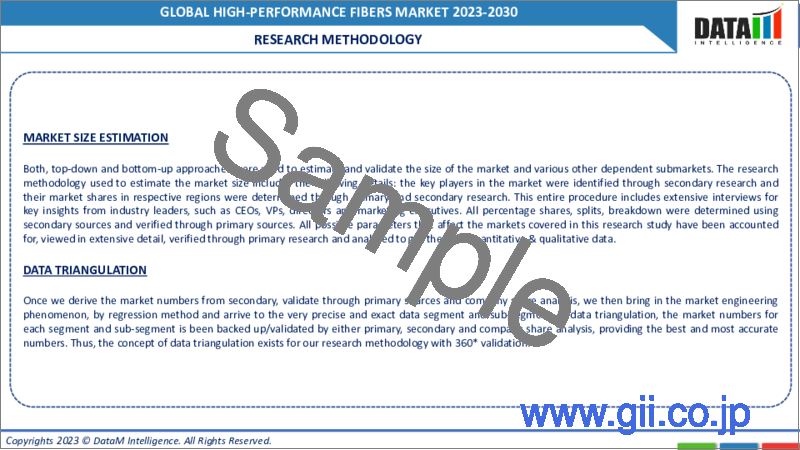|
|
市場調査レポート
商品コード
1290422
高機能繊維の世界市場- 2023-2030Global High-Performance Fibers Market - 2023-2030 |
||||||
カスタマイズ可能
適宜更新あり
|
|||||||
| 高機能繊維の世界市場- 2023-2030 |
|
出版日: 2023年06月12日
発行: DataM Intelligence
ページ情報: 英文 204 Pages
納期: 即日から翌営業日
|
- 全表示
- 概要
- 目次
市場の概要
高機能繊維の世界市場は、2022年に110億米ドルに達し、2023年から2030年の予測期間中にCAGR7.4%で成長し、2030年には230億米ドルに達すると予測されています。
高機能繊維は、技術の進歩に伴い、航空宇宙や自動車などの生産に頻繁に使用されています。各社は、これからの市場において、エンドユーザーによる使用や管理が簡単な軽量製品のニーズに応えるため、高機能繊維市場の研究開発に注力しています。
世界の高機能繊維市場は、著しい耐久性と耐久性を備えた高品質の製品への需要の高まりにより拡大しています。また、政府のセキュリティ規制や衝突による死亡者数の減少も、自動車産業における高機能繊維の需要を高め、予測期間中の同分野の成長を支えています。
市場力学
再生可能資源別発電量の増加
高機能繊維の世界市場は、CO2排出量削減のための再生可能資源による発電需要の高まりによって牽引されると予想されます。環境に対する関心の高まりや非再生可能資源の資源不足を背景に、風力発電や水力発電の生産が拡大しています。炭素繊維は、高い圧力に耐え、炎や化学物質、粉塵に強いため、風車や水車のブレードに使用されています。
そのため、再生可能な資源の使用とともに、高性能な繊維のニーズが高まっています。数メガワットの定格出力が大型化する中、最新の風力タービンはより経済的で効率的なものとなっています。米国エネルギー省は、2020年の新規風力発電所の年間投資額を約100億米ドルと推定しています。今後5年間で、陸上風力発電180件、洋上風力発電17件、合計840億米ドルのプロジェクトが計画されています。
認識不足とサステナビリティへの懸念
高機能繊維の世界市場は、認知度の低さから成長が鈍化すると思われます。高機能繊維は、その優れた特性にもかかわらず、多くの産業であまり知られておらず、理解されていないです。特に中小企業や従来素材に頼ってきた分野では、その利点や用途が理解されていないため、採用が妨げられる可能性があります。
高機能繊維の製造には合成素材が頻繁に使用されるため、環境維持の問題が発生する可能性があります。原材料の採取や加工、エネルギーの使用、生産時の廃棄物の発生や廃棄によって、生態系に影響を与える可能性があります。消費者や産業界では持続可能な素材が優先されており、持続可能な代替品や生産技術が確立されるまでは、高機能繊維市場の成長の障害となる可能性があります。
COVID-19の影響分析
パンデミックにより、消費者行動と市場需要に大きな変化が生じた。旅行制限や経済活動の低下により、航空宇宙や自動車などいくつかの業界では、需要の大幅な減少が見られました。航空機の生産台数や自動車の販売台数の減少につながりました。一方、高機能繊維は、ヘルスケア、個人用保護具(PPE)、メディカルテキスタイルなどの業界からの需要が増加し、特に手術着やマスクなどの保護具の用途で需要が増加しました。
自動車産業は、特殊自動車や高性能自動車などの一部の例外を除いて、現在回復過程にあります。素材が高価なため、高性能な炭素繊維の使用はまだ始まったばかりです。しかし、パンデミック後、業界は回復し、今後数年間は急速に拡大すると予想されます。
ロシア・ウクライナ紛争の影響分析
ロシアとウクライナの紛争は、地政学的リスクと不確実性を高め、市場の安定と投資家の信頼に影響を及ぼしています。紛争の期間や結果に関する不確実性により、高機能繊維の市場への投資が抑制される可能性があります。投資家は慎重な姿勢をとり、設備投資や拡張計画の延期や撤回を行う可能性があります。
原油や食料などの必須原材料のコスト増が人件費を押し上げ、世界の高機能繊維市場にとって大きな懸念材料となります。市場の成長とイノベーションを妨げ、新しい高機能繊維の技術とアプリケーションの開拓に影響を与える可能性があります。
AIによる影響分析
人工知能(AI)ベースのソリューションは、高機能繊維の生産プロセスの効率と品質を向上させることができます。一貫したレベルの製品品質を維持するために、機械学習アルゴリズムはリアルタイムのセンサーデータを分析し、繊維の生産中に温度、圧力、張力などの条件を追跡して、リアルタイムで修正を加えることがあります。
生産コストは削減され、エラーは減少し、自動化と制御のレベルに応じて全体的な生産性は向上します。AIは、Wolfram Alphaのようなツールを使って複雑な計算を行うことで、研究者が新しいアイデアやコンセプトの実現可能性を判断するのを助け、生産的な研究の方向へ導くことができます。
目次
第1章 調査手法と範囲
- 調査手法
- 調査目的および調査範囲
第2章 定義と概要
第3章 エグゼクティブサマリー
- 市場内訳:製品別
- 市場内訳:アプリケーション別
- 市場内訳:エンドユーザー別
- 市場内訳:地域別
第4章 市場力学
- 影響要因
- 促進要因
- 再生可能資源別発電量の増加
- 有機高機能繊維の需要増加
- 抑制要因
- 高コストと非生分解性
- 認識不足と持続可能性への懸念
- 機会
- 影響分析
- 促進要因
第5章 産業分析
- ポーターのファイブフォース分析
- サプライチェーン分析
- 価格分析
- 法規制の分析
第6章 COVID-19の分析
第7章 製品別
- カーボンファイバー
- ポリベンゾイミダゾール(PBI)
- アラミド繊維
- M5/PIPD
- 高強度ポリエチレン
- ガラス繊維
- ポリベンゾオキサゾール(PBO)
- その他
第8章 用途別
- フレキシブルテクニカルテキスタイル
- 高強度ロープ
- 硬質コンポジット
- その他
第9章 エンドユーザー別
- 航空宇宙・防衛
- 建設・建築
- エレクトロニクス・通信
- 繊維
- 自動車
- その他
第10章 地域別
- 北米
- 米国
- カナダ
- メキシコ
- 欧州
- ドイツ
- 英国
- フランス
- イタリア
- スペイン
- その他欧州
- 南米
- ブラジル
- アルゼンチン
- その他南米地域
- アジア太平洋地域
- 中国
- インド
- 日本
- オーストラリア
- その他アジア太平洋地域
- 中東・アフリカ地域
第11章 競合情勢
- 競合シナリオ
- 市況/シェア分析
- M&A(合併・買収)分析
第12章 企業プロファイル
- Hyosung Advanced Materials
- 会社概要
- 製品ポートフォリオと説明
- 主なハイライト
- 財務概要
- Bally Ribbon Mills
- 3B-the fiberglass company
- Honeywell International Inc
- The InterTech Group, Inc
- JEC Group
- Koninklijke DSM N.V
- Sarla Performance Fibers Limited
- KUREHA CORPORATION
- SRO Group
第13章 付録
Market Overview
Global High-Performance Fibers Market reached US$ 11 billion in 2022 and is expected to reach US$ 23 billion by 2030, growing with a CAGR of 7.4% during the forecast period 2023-2030.
High-performance fibers are used frequently in the production of aerospace, automobiles and other products as technology advances. The players are concentrating on research and development in the high-performance fibers market to meet the need for lightweight products that are simple to use and manage by the end-users in the coming market.
The Global High-Performance Fibers Market is expanding due to the growing demand for high-quality products with significant endurance and durability. Government security regulations and a decline in crash fatalities have also enhanced demand for high-performance fibers in the automotive industry, supporting the sector's growth during the forecast period.
Market Dynamics
Rising Power Generation from Renewable Resources
The global market for high-performance fibers is anticipated to be driven by the growing demand of power generation from renewable sources to reduce CO2 emissions. The production of wind and water power is growing as a result of increasing concerns about the environment and a shortage of resources for non-renewables. Carbon fibers are used to make wind or water turbine blades because they endure high pressure and are resistant to flames, chemicals and dust.
As a result, the need for high-performance fibers has grown along with the use of renewable resources. With multi-megawatt power ratings growing up in size, modern wind turbines are more economical and efficient. U.S. Energy Department estimates that new wind farms annual investments was around US$10 billion in 2020. 180 onshore and 17 offshore wind projects totaling US$84 billion for the next five years are planned.
Lack of Awareness and Sustainability Concerns
The global market for high-performance fiber will grow slowly as a result of lack of awareness. High-performance fibers are not well known or understood across many industries, despite their extraordinary properties. Their adoption may be hampered by a lack of understanding of their advantages and uses, especially in smaller businesses or sectors historically relying on conventional materials.
Since synthetic materials are frequently used to create high-performance fibers, environmental sustainability issues may arise. An ecological impact can be caused by the extraction and processing of raw materials, energy use, waste production during production and disposal. Sustainable materials are being prioritized by consumers and industries, which may create obstacles for high-performance fibers market growth until sustainable alternatives or production techniques are created.
COVID-19 Impact Analysis
Significant changes in consumer behavior and market demand were caused by the pandemic. Due to travel restrictions and decreased economic activity, several industries, such as aerospace and automotive, saw a severe reduction in demand. It led to a decline in aircraft production and auto sales. On the other hand, high-performance fibers saw a rise in demand from industries including healthcare, personal protective equipment (PPE) and medical textiles, notably for uses like surgical gowns, masks and other protective gear.
The automotive industry is currently in the process of recovering, with a few notable exceptions, such as specialised and high-performance automobiles. Due to the high cost of the material, the use of high performance carbon fibers is still in its infancy. But after the pandemic, the industry has recovered and is expected to expand rapidly over the coming years.
Russia-Ukraine War Impact Analysis
The conflict between Russia and Ukraine has increased geopolitical risk and uncertainty, which affects market stability and investor confidence. Investment in the market for high performance fibers may be discouraged by uncertainty regarding the conflict's duration and result. Investors can take a cautious stance, postponing or revoking capital investments and expansion plans.
The growing cost of essential raw materials like crude oil and food, which boosts labor costs, is a major source of concern for the global high-performance fibers market. It could hinder market growth and innovation, affecting the development of new high-performance fiber technology and applications.
AI Impact Analysis
Artificial intelligence (AI)-based solutions can improve the efficiency and quality of high-performance fiber production processes. In order to maintain a consistent level of product quality, machine learning algorithms may analyse real-time sensor data, track conditions like temperature, pressure and tension during the production of fibers and make modifications in real-time.
Production costs are reduced, errors are decreased and overall productivity is raised with the level of automation and control. By performing complex calculations with the aid of tools like Wolfram Alpha, AI may assist researchers in determining the feasibility of novel ideas and concepts, leading them in the direction of productive research avenues.
Segment Analysis
The global high-performance fibers market is segmented based on product, application, end-user and region.
The Rising Demand for Lightweight Materials in Aerospace & Defense
The aerospace and defence sector, which is the largest, is projected to account for about 1/3rd of the global high-performance fibers market. The industry is going towards lightweight materials to increase the aircraft's cost-effectiveness and environmental performance and it is predicted to result in a high CAGR between 2022 and 2030.
As a result, high-strength, lightweight and composite materials with fiber reinforcement are essential for the development of airplanes, which is fueling the market's expansion. For instance, Hexcel and Dassault inked a long-term contract in July 2022 for Hexcel to provide carbon fiber prepreg for the Falcon 10X program. In order to manufacture its aircraft wings, it is the first Dassault business jet program to use high-performance advanced carbon fiber composites.
Geographical Analysis
The Growing Demand for Fiber-Reinforced Composites in Asia-Pacific
The Asia-Pacific market for high-performance fibers is estimated to grow fastest throughout the projected period due to a rise in demand for fiber-reinforced composite materials in the construction, electronics and automotive industries. Additionally, the market is anticipated to be driven by industry leaders' establishment of production facilities and the availability of raw materials.
In countries like China, the automotive, aerospace and defense industries typically use high-performance fibers because they provide the required strength, endurance and stability. According to Boeing's Commercial Outlook 2022-2041, 8,485 new deliveries with a market service value of US$ 545 billion are predicted to be made in China by 2041. According to estimates, the nation's new deliveries will boost carbon fiber demand and propel the region's high-performance fibers market.
Competitive Landscape
The major global players include: Hyosung Advanced Materials, Bally Ribbon Mills, 3B - the fiberglass company, Honeywell International Inc, The InterTech Group, Inc, JEC Group, Koninklijke DSM N.V, Sarla Performance Fibers Limited, KUREHA CORPORATION and SRO Group.
Why Purchase the Report?
- To visualize the Global High Performance Fibers Market segmentation based on product, application, end-user and region and understand key commercial assets and players.
- Identify commercial opportunities by analyzing trends and co-development.
- Excel data sheet with numerous data points of high-performance fibers market-level with all segments.
- PDF report consists of a comprehensive analysis after exhaustive qualitative interviews and an in-depth study.
- Product mapping available as excel consisting of key products of all the major players.
The Global High-Performance Fibers Market Report Would Provide Approximately 61 Tables, 66 Figures And 204 pages.
Target Audience 2023
- Manufacturers/ Buyers
- Industry Investors/Investment Bankers
- Research Professionals
- Emerging Companies
Table of Contents
1. Methodology and Scope
- 1.1. Research Methodology
- 1.2. Research Objective and Scope of the Report
2. Definition and Overview
3. Executive Summary
- 3.1. Market Snippet By Product
- 3.2. Market Snippet By Application
- 3.3. Market Snippet By End-User
- 3.4. Market Snippet By Region
4. Dynamics
- 4.1. Impacting Factors
- 4.1.1. Drivers
- 4.1.1.1. Rising Power Generation from Renewable Resources
- 4.1.1.2. Rising demand for Organic High Performance Fibers
- 4.1.2. Restraints
- 4.1.2.1. High costs and non-biodegradability
- 4.1.2.2. Lack of awareness and sustainability concerns
- 4.1.3. Opportunity
- 4.1.4. Impact Analysis
- 4.1.1. Drivers
5. Industry Analysis
- 5.1. Porter's Five Force Analysis
- 5.2. Supply Chain Analysis
- 5.3. Pricing Analysis
- 5.4. Regulatory Analysis
6. COVID-19 Analysis
- 6.1. Analysis of COVID-19
- 6.1.1. Scenario Before COVID
- 6.1.2. Scenarios During COVID
- 6.1.3. Scenario Post COVID
- 6.2. Pricing Dynamics Amid COVID-19
- 6.3. Demand-Supply Spectrum
- 6.4. Government Initiatives Related to the Market During Pandemic
- 6.5. Manufacturers Strategic Initiatives
- 6.6. Conclusion
7. By Product
- 7.1. Introduction
- 7.1.1. Market Size Analysis and Y-o-Y Growth Analysis (%), By Product
- 7.1.2. Market Attractiveness Index, By Product
- 7.2. Carbon Fiber*
- 7.2.1. Introduction
- 7.2.2. Market Size Analysis and Y-o-Y Growth Analysis (%)
- 7.3. Polybenzimidazole (PBI)
- 7.4. Aramid Fiber
- 7.5. M5/PIPD
- 7.6. High Strength Polyethylene
- 7.7. Glass Fiber
- 7.8. Polybenzoxazole (PBO)
- 7.9. Others
8. By Application
- 8.1. Introduction
- 8.1.1. Market Size Analysis and Y-o-Y Growth Analysis (%), By Application
- 8.1.2. Market Attractiveness Index, By Application
- 8.2. Flexible technical textiles*
- 8.2.1. Introduction
- 8.2.2. Market Size Analysis and Y-o-Y Growth Analysis (%)
- 8.3. High-strength ropes
- 8.4. Rigid composites
- 8.5. Others
9. By End-User
- 9.1. Introduction
- 9.1.1. Market Size Analysis and Y-o-Y Growth Analysis (%), By End-User
- 9.1.2. Market Attractiveness Index, By End-User
- 9.2. Aerospace & Defense*
- 9.2.1. Introduction
- 9.2.2. Market Size Analysis and Y-o-Y Growth Analysis (%)
- 9.3. Construction & Building
- 9.4. Electronics & Telecommunication
- 9.5. Textile
- 9.6. Automotive
- 9.7. Others
10. By Region
- 10.1. Introduction
- 10.2. Market Size Analysis and Y-o-Y Growth Analysis (%), By Region
- 10.3. Market Attractiveness Index, By Region
- 10.4. North America
- 10.4.1. Introduction
- 10.4.2. Key Region-Specific Dynamics
- 10.4.3. Market Size Analysis and Y-o-Y Growth Analysis (%), By Product
- 10.4.4. Market Size Analysis and Y-o-Y Growth Analysis (%), By Application
- 10.4.5. Market Size Analysis and Y-o-Y Growth Analysis (%), By End-User
- 10.4.6. Market Size Analysis and Y-o-Y Growth Analysis (%), By Country
- 10.4.6.1. The U.S.
- 10.4.6.2. Canada
- 10.4.6.3. Mexico
- 10.5. Europe
- 10.5.1. Introduction
- 10.5.2. Key Region-Specific Dynamics
- 10.5.3. Market Size Analysis and Y-o-Y Growth Analysis (%), By Product
- 10.5.4. Market Size Analysis and Y-o-Y Growth Analysis (%), By Application
- 10.5.5. Market Size Analysis and Y-o-Y Growth Analysis (%), By End-User
- 10.5.6. Market Size Analysis and Y-o-Y Growth Analysis (%), By Country
- 10.5.6.1. Germany
- 10.5.6.2. The UK
- 10.5.6.3. France
- 10.5.6.4. Italy
- 10.5.6.5. Spain
- 10.5.6.6. Rest of Europe
- 10.6. South America
- 10.6.1. Introduction
- 10.6.2. Key Region-Specific Dynamics
- 10.6.3. Market Size Analysis and Y-o-Y Growth Analysis (%), By Product
- 10.6.4. Market Size Analysis and Y-o-Y Growth Analysis (%), By Application
- 10.6.5. Market Size Analysis and Y-o-Y Growth Analysis (%), By End-User
- 10.6.6. Market Size Analysis and Y-o-Y Growth Analysis (%), By Country
- 10.6.6.1. Brazil
- 10.6.6.2. Argentina
- 10.6.6.3. Rest of South America
- 10.7. Asia-Pacific
- 10.7.1. Introduction
- 10.7.2. Key Region-Specific Dynamics
- 10.7.3. Market Size Analysis and Y-o-Y Growth Analysis (%), By Product
- 10.7.4. Market Size Analysis and Y-o-Y Growth Analysis (%), By Application
- 10.7.5. Market Size Analysis and Y-o-Y Growth Analysis (%), By End-User
- 10.7.6. Market Size Analysis and Y-o-Y Growth Analysis (%), By Country
- 10.7.6.1. China
- 10.7.6.2. India
- 10.7.6.3. Japan
- 10.7.6.4. Australia
- 10.7.6.5. Rest of Asia-Pacific
- 10.8. Middle East and Africa
- 10.8.1. Introduction
- 10.8.2. Key Region-Specific Dynamics
- 10.8.3. Market Size Analysis and Y-o-Y Growth Analysis (%), By Product
- 10.8.4. Market Size Analysis and Y-o-Y Growth Analysis (%), By Application
- 10.8.5. Market Size Analysis and Y-o-Y Growth Analysis (%), By End-User
11. Competitive Landscape
- 11.1. Competitive Scenario
- 11.2. Market Positioning/Share Analysis
- 11.3. Mergers and Acquisitions Analysis
12. Company Profiles
- 12.1. Hyosung Advanced Materials
- 12.1.1. Company Overview
- 12.1.2. Product Portfolio and Description
- 12.1.3. Key Highlights
- 12.1.4. Financial Overview
- 12.2. Bally Ribbon Mills
- 12.3. 3B - the fiberglass company
- 12.4. Honeywell International Inc
- 12.5. The InterTech Group, Inc
- 12.6. JEC Group
- 12.7. Koninklijke DSM N.V
- 12.8. Sarla Performance Fibers Limited
- 12.9. KUREHA CORPORATION
- 12.10. SRO Group
LIST NOT EXHAUSTIVE
13. Appendix
- 13.1. About Us and Services
- 13.2. Contact Us





